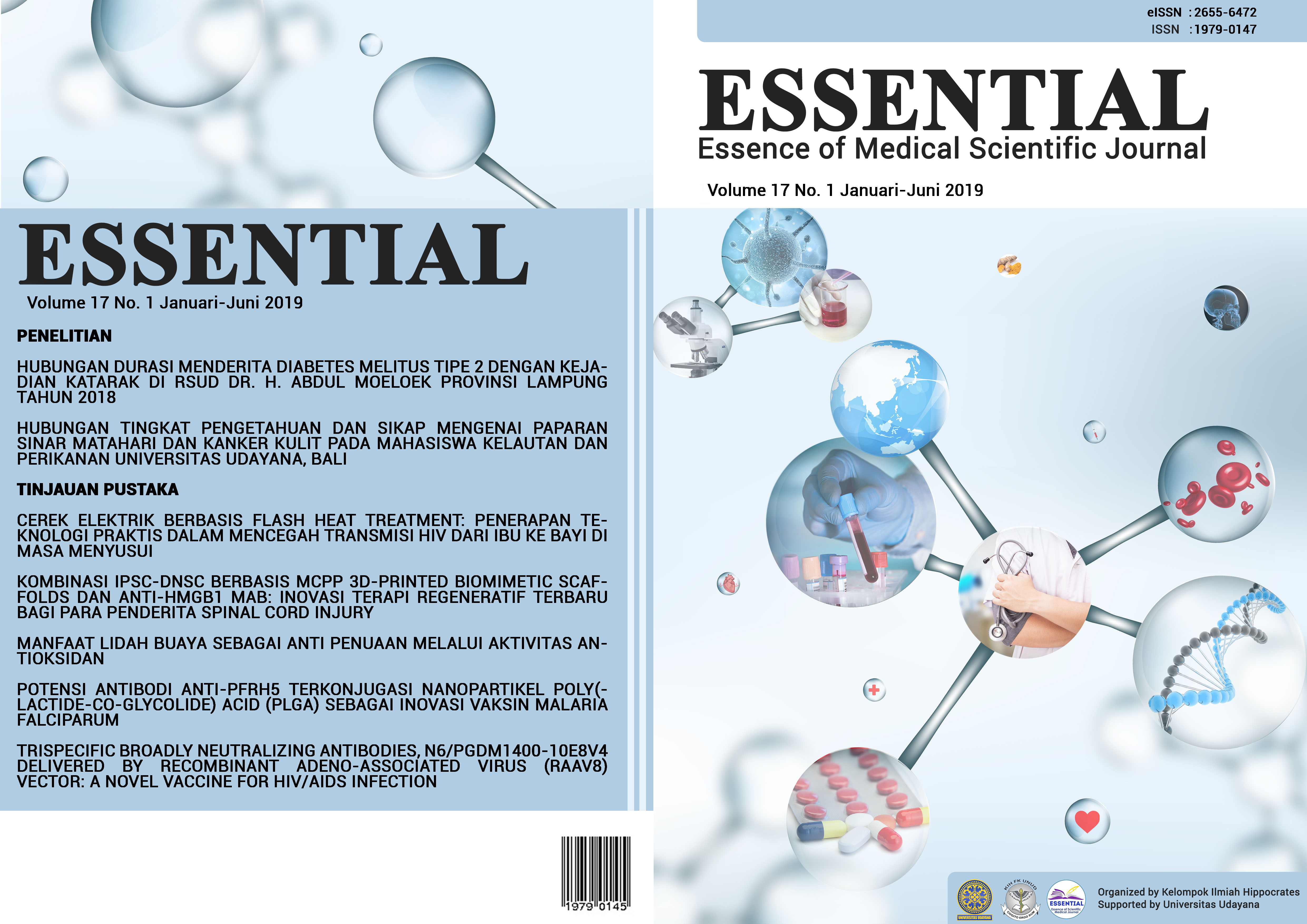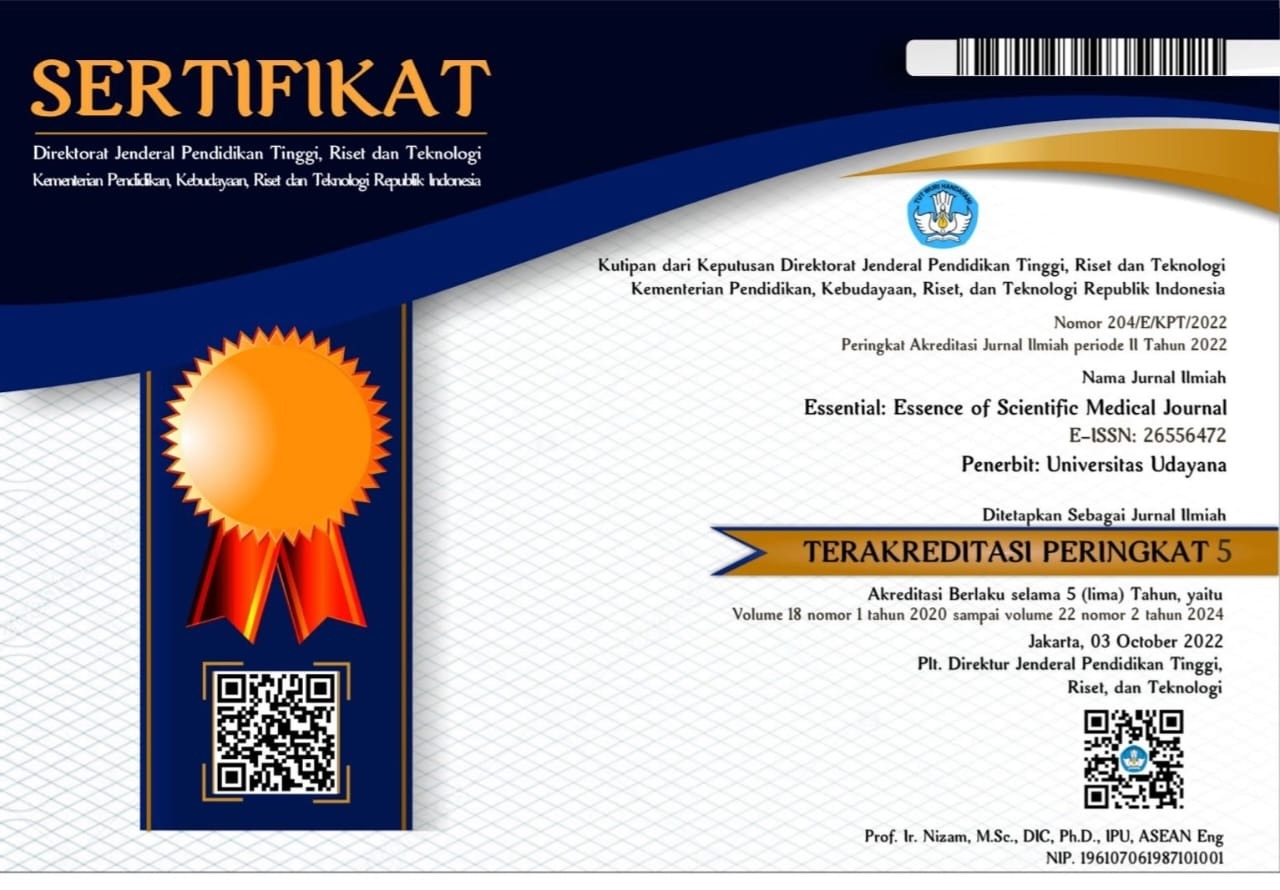Potensi Antibodi Anti-PfRH5 Terkonjugasi Nanopartikel Poly(lactide-co-glycolide) acid (PLGA) sebagai Inovasi Vaksin Malaria Falciparum
Abstract
Malaria Falciparum adalah salah satu penyakit infeksi disebabkan oleh parasit protozoa Plasmodium falciparum yang memiliki morbiditas dan mortalitas terbesar kasus malaria pada manusia. Upaya pencegahan dan penanganan malaria falciparum saat ini masih mendapat hambatan dari resistensi terhadap insektisida dan obat anti-malaria. Untuk itu, perlu adanya metode pencegahan parasit yang bersifat lebih spesifik yakni berupa vaksin dengan target protein parasit. Tinjauan pustaka dilakukan berdasarkan literatur seperti jurnal dan website. Dari 60 jurnal yang ditelaah, 46 jurnal ditemukan sesuai dengan topik bahasan dan digunakan sebagai referensi karya ini. Dalam siklus hidup P.falciparum terjadi fase invasi terhadap eritrosit. Plasmodium falciparum Reticulocyte-binding Protein Homologue 5 (PfRH5) dan basigin (BSG) dari eritrosit adalah pasangan ligan-reseptor esensial dalam invasi eritrosit. Tambahan nanopartikel poly(lactide-co-glycolide) acid (PLGA) sangat penting untuk melindungi komponen vaksin antibodi anti-PfRH5 agar tidak mudah mengalami degradasi yang membantu untuk meningkatkan efikasi kerja vaksin dalam menginhibisi proses invasi oleh merozoit. Karena berperan sebagai target yang penting dalam menginhibisi invasi merozoit, potensi PfRH5 sebagai vaksin malaria sangat signifikan dan spesifik. Potensi PfRH5 juga didukung dengan munculnya respon imun alami yang dapat menghambat pertumbuhan parasit. Respon imun tersebut melibatkan IgG spesifik terhadap PfRH5 yang dapat memberikan efek protektif dengan menghambat terjadinya ikatan antara PfRH5-BSG sehingga proses invasi tidak terjadi. Vaksin malaria (antibody anti-PfRH5 terkonjugasi nanopartikel PLGA) yang spesifik pada merozoit merupakan modalitas pencegahan potensial dalam perkembangan vaksin malaria falciparum. Penelitian lebih lanjut diperlukan untuk mengetahui efikasi dan induksi antibodi pada tubuh oleh anti-PfRH5 masih diperlukan untuk menambah bukti ilmiah.
Downloads
References
2. WHO | Malaria. World Health Organization; [cited 2016 Sept 8]; Available from: http://www.who.int/mediacentre/factsheets/fs094/en/
3. Patel SD, Ahouidi AD, Bei AK, Dieye TN, Mboup S, Harrison SC, et al. Plasmodium falciparum Merozoite Surface Antigen , PfRH5 , Elicits Detectable Levels of Invasion-Inhibiting Antibodies in Humans. 2013;208:1679–87.
4. Kemkes RI. Epidemiologi Malaria di Indonesia. Buletin Jendela Data dan Informasi Kesehatan, Jakarta: Bakti Husada. 2011.
5. Hayton K, Gaur D, Liu A, Takahashi J, Henschen B, Singh S, et al. Erythrocyte binding protein PfRH5 polymorphisms determine species-specific pathways of Plasmodium falciparum invasion. Cell Host & Microbe. 2008 Jul 17;4(1):40-51.
6. Ppbb D, Pp D, Pl DAN, Ri KK. Buku saku menuju eliminasi malaria.
7. Srinivas. Malaria Site; [cited 2016 Sept 9]; Available from: http://www.malariasite.com/drug-resistance/
8. Petersen I, Eastman R, Lanzer M. Drug‐resistant malaria: Molecular mechanisms and implications for public health. FEBS letters. 2011 Jun 6;585(11):1551-62.
9. WHO. WHO’s emergency response to artemisinin resistance. World Health Organization. 2016.
10. Treatment FORTHE, Malaria OF. For the treatment of malaria.
11. Zenonos ZA, Dummler SK, Müller-sienerth N, Chen J, Preiser PR, Rayner JC, et al. Basigin is a druggable target for host- oriented antimalarial interventions.
12. Draper SJ, Angov E, Horii T, Miller LH, Srinivasan P, Theisen M, et al. Recent advances in recombinant protein-based malaria vaccines. Vaccine. 2015 Dec 22;33(52):7433-43.
13. Agnandji ST, Lell B, Fernandes JF, Abossolo BP, Methogo BG, Kabwende AL, et al. A phase 3 trial of RTS, S/AS01 malaria vaccine in African infants. The New England journal of medicine. 2012 Dec;367(24):2284-95.
14. Wright KE, Hjerrild KA, Bartlett J, Douglas AD, Jin J, Brown RE, et al. Structure of malaria invasion protein RH5 with erythrocyte basigin and blocking antibodies. Nature. 2014 Nov 20;515(7527):427-30.
15. Volz JC, Yap A, Sisquella X, Thompson JK, Lim NT, Whitehead LW, et al. Essential role of the PfRh5/PfRipr/CyRPA Complex during Plasmodium falciparum Invasion of Erythrocytes. Cell Host & Microbe. 2016 Jul 13;20(1):60-71.
16. Douglas AD, Williams AR, Illingworth JJ, Kamuyu G, Biswas S, Goodman AL, et al. The blood-stage malaria antigen PfRH5 is susceptible to vaccine-inducible cross-strain neutralizing antibody. Nature Communications. 2011 Dec 20;2:601.
17. Bustamante LY, Bartholdson SJ, Crosnier C, Campos MG, Wanaguru M, Nguon C, et al. A full-length recombinant Plasmodium falciparum PfRH5 protein induces inhibitory antibodies that are effective across common PfRH5 genetic variants. Vaccine. 2013; 31:373–9.
18. Ord RL, Caldeira JC, Rodriguez M, Noe A, Chackerian B, Peabody DS, et al. A malaria vaccine candidate based on an epitope of the Plasmodium falciparum RH5 protein. Malaria Journal. 2014 Aug 18;13(1):1.
19. Reddy KS, Amlabu E, Pandey AK, Mitra P, Chauhan VS, Gaur D. Multiprotein complex between the GPI-anchored CyRPA with PfRH5 and PfRipr is crucial for Plasmodium falciparum erythrocyte invasion. 2015;112(4).
20. Powles L, Xiang SD, Selomulya C, Plebanski M. The use of synthetic carriers in malaria vaccine design. Vaccines. 2015 Oct 29;3:894-929.
21. Hajizade A, Ebrahimi F, Salmanian AH, Arpanaei A, Amani J. Nanoparticles in vaccine development. J Applied Biotechnology Reports. 2014;1(4):125-134.
22. Kalluru R, Fenaroli F, Westmoreland D, Ulanova L, Maleki A, Roos N, et al. Poly(lactide-co-glycolide)-rifampicin nanoparticles efficiently clear Mycobacterium bovis BCG infection in macrophages and remain membrane-bound in phago-lysosomes. J Cell Sci. 2013;126(14):3043–54.
23. Sinka ME, Bangs MJ, Manguin S, Rubio-Palis Y, Chareonviriyaphap T, Coetzee M, et al. A global map of dominant malaria vectors. Parasites & vectors. 2012 Apr 4;5(1):1.
24. Fauci AS. Harrison's principles of internal medicine. McGraw-Hill, Medical Publishing Division; 2008
25. Weekley C, Smith DS. Malaria: the clinical basics. Global Health Education Consortium (GHEC). 2013 Feb.
26. Sutanto I, Sumariah I, Pudji K, Saleha S. Buku ajar parasitologi. Fakultas Kedokteran Universitas Indonesia. Balai Penerbit FKUI: 2009:189-207.
27. Kasper DL, Fauci AS. Harrison’s infectious diseases. 2nd ed. New York: McGraw Hill Professional, 2013.
28. Beeson JG, Drew DR, Boyle MJ, Feng G, Fowkes FJ, Richards JS. Merozoite surface proteins in red blood cell invasion, immunity and vaccines against malaria. FEMS microbiology reviews. 2016 May 1;40(3):343-72.
29. Gilson PR, Crabb BS. Morphology and kinetics of the three distinct phases of red blood cell invasion by Plasmodium falciparum merozoites. International journal for parasitology. 2009 Jan 31;39(1):91-6.
30. Weiss GE, Gilson PR, Taechalertpaisarn T, Tham WH, de Jong NW, Harvey KL, Fowkes FJ, Barlow PN, Rayner JC, Wright GJ, Cowman AF. Revealing the sequence and resulting cellular morphology of receptor-ligand interactions during Plasmodium falciparum invasion of erythrocytes. PLoS Pathog. 2015 Feb 27;11(2):e1004670.
31. Riglar DT, Richard D, Wilson DW, Boyle MJ, Dekiwadia C, Turnbull L, et al. Super-resolution dissection of coordinated events during malaria parasite invasion of the human erythrocyte. Cell host & microbe. 2011 Jan 20;9(1):9-20.
32. Tham WH, Healer J, Cowman AF. Erythrocyte and reticulocyte binding-like proteins of Plasmodium falciparum. Trends in parasitology. 2012 Jan 31;28(1):23-30.
33. Singh S, Alam MM, Pal-Bhowmick I, Brzostowski JA, Chitnis CE. Distinct external signals trigger sequential release of apical organelles during erythrocyte invasion by malaria parasites. PLoS Pathog. 2010 Feb 5;6(2):e1000746.
34. Cowman AF, Crabb BS. Invasion of red blood cells by malaria parasites. Cell. 2006 Feb 24;124(4):755-66.
35. Chen L, Lopaticki S, Riglar DT, Dekiwadia C, Uboldi AD, Tham WH, et al. An EGF-like protein forms a complex with PfRh5 and is required for invasion of human erythrocytes by Plasmodium falciparum. PLoS Pathog. 2011; 7:e1002199.
36. Crosnier C, Bustamante LY, Bartholdson SJ, Bei AK, Theron M, Uchikawa M, et al. Basigin is a receptor essential for erythrocyte invasion Bay Plasmodium falciparum. Nature. 2011;480:534–37.
37. Baum J, Chen L, Healer J, Lopaticki S, Boyle M, Triglia T, et al. Reticulocyte-binding protein homologue 5–an essential adhesin involved in invasion of human erythrocytes by Plasmodium falciparum. International journal for parasitology. 2009 Feb 28;39(3):371-80.
38. Dreyer AM, Matile H, Papastogiannidis P, Kamber J, Favuzza P, Voss TS, Wittlin S, Pluschke G. Passive immunoprotection of Plasmodium falciparum-infected mice designates the CyRPA as candidate malaria vaccine antigen .J Immonol. 2012 Jun 15;188(12):6225-37.
39. Manske M, et al. Analysis of Plasmodium falciparum diversity in natural infections by deep sequencing. Nature. 2012; 487:375–379. [PubMed: 22722859].
40. Williams AR, et al. Enhancing blockade of Plasmodium falciparum erythrocyte invasion: assessing combinations of antibodies against PfRH5 and other merozoite antigens. PLoS Pathog. 2012; 8:e1002991. [PubMed: 23144611].
41. Paul S, Bhattacharyya SS, Boujedaini N, Khuda-Bukhsh AR. Anticancer potentials of root extract of polygala senega and its PLGA nanoparticles-encapsulated form. Evid Based Complement Alternat Med. 2011: 13.
42. Slingerland M. Exploring novel formulations and new classes of anticancer drugs in solid tumors (Doctoral dissertation, Department of Clinical Oncology and Clincal Pharmacy and Toxicology, Faculty of medicine/Leiden University Medical Center (LUMC), Leiden University), 2014.
43. Douglas AD, Williams AR, Illingworth JJ, et al. Europe PMC Funders Group The Blood-Stage Malaria Antigen PfRH5 is Susceptible to Vaccine-Inducible Cross-Strain Neutralizing Antibody. 2012.
44. Douglas AD, Williams AR, Knuepfer E, et al. Europe PMC Funders Group Neutralization of Plasmodium falciparum merozoites by antibodies against PfRH5. 2014;192(1):1-33. doi:10.4049/jimmunol.1302045.Neutralization.
45. Mishra RP, Orta OE, Prachie P, Rappuoli R, Bagnoli F. Vaccines and antibiotic resistance. Curr Opin Microbiol; 2012; 15(5):596-602.
46. Zenonos ZA, Dummler SK, Müller-sienerth N, Chen J, Preiser PR, Rayner JC, et al. Basigin is a druggable target for host- oriented antimalarial interventions. 2015;212(8):1145–51.


 SUBMISSION
SUBMISSION
















